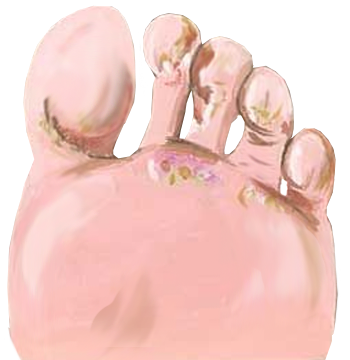What is Athletes Foot?

When we think about athletes feet, most of us associate this condition with athletes only. However, it’s quite the contrary, anyone can get it. This condition is common in individuals whose feet sweat often while in tightfitting shoes, although it can also spread to the hands and toenails.
Typically, athletes foot is not a very serious condition. However, it can be hard to cure and even though a lot of people try to treat this over the counter, it’s important to see a doctor for reoccurrences.
If you have diabetes and suspect you have athletes foot, call the doctor immediately. This can develop into something very serious for diabetics.
Athletes Foot Symptoms
There are many symptoms that come with athletes foot, including the following:
- Cracking and peeling skin on your feet, most commonly between your toes and on your soles
- Discolored, thick, and crumbly toenails
- Itching, stinging and burning between your toes or on soles of your feet
- Dry skin on your soles or sides of your feet
- Raw skin on your feet
- Toenails that pull away from the nail bed
- Blisters on your feet that itch
What are the Causes of Athletes Foot?
Athlete’s foot occurs when the tinea fungus grows on your feet. This fungus is highly contagious and it is very important not to spread it. Avoid any direct contact with an infected person to make sure not to become contaminated. Many people tend to get the condition from sharing showers, pools and locker rooms.
There are certain behaviors that increase your risk of becoming infected with athletes foot, such as:
- Being in public areas barefoot, especially showers, locker rooms, and swimming pools
- A minor nail injury on your foot
- Sweaty feets
- Wearing tight closed-toed shoes
- Sharing shoes, socks, or towels with someone with the condition
- Not drying off your feet for a long period of time
Can Complications Arise?
It’s rare to experience complications associated with athletes foot. However, if left untreated, your risk increases greatly for complications.
If left untreated, the following could occur:
- Fungal nail infection: Untreated athlete’s foot can spread to toenails in a condition known as onychomycosis. The nail becomes thick, opaque, whitish, and crumbly. There may be pain and inflammation in the skin under the nail. Untreated toenail infections may eventually lead to more pain and problems wearing shoes, or even walking.
- Infected lymph system: The infection can sometimes spread to the lymph system. Lymphangitis is an infection of the lymph vessels, and lymphadenitis is an infection of the lymph nodes.
- Secondary bacterial infection: If this develops the foot may become painful, hot, and swollen.
- Cellulitis: This is a bacterial infection deep in the skin. Skin, fat, and soft tissue may be affected. Untreated cellulitis can lead to serious complications, such as septicemia (blood poisoning) or bone infection. Although a very rare complication of an athlete’s foot, cellulitis should be treated immediately with antibiotics.
- Allergy: Some people are allergic to the fungus that causes athlete’s foot, this can cause blistering on the hands or feet.
How is the Condition Diagnosed?
It’s typical for a physician to diagnose athletes foot by the symptoms. However, if the fungal infection is unknown or rapidly spreading, your doctor might order a skin test.
A skin lesion potassium hydroxide exam is the most common test for athlete’s foot. A doctor scrapes off a small area of infected skin and places it in potassium hydroxide. The KOH destroys normal cells and leaves the fungal cells untouched so they are easy to see under a microscope.
Athletes Foot Treatment
Athlete’s foot can sometimes be treated over the counter. Although there are times when a prescription is necessary due to reoccurring athletes foot or the severity.
Doctors often recommend the following:
Over the Counter Medication:
- Terbinafine (Lamisil AT)
- Miconazole (Desenex)
- Tolnaftate (Tinactin)
- Butenafine (Lotrimin Ultra)
- Clotrimazole (Lotrimin AF)
Prescribed Medications:
- Oral antibiotics if bacterial infections develop due to raw skin and blisters
- Topical, prescription-strength clotrimazole or miconazole
- Oral antifungal medications such as itraconazole (Sporanox), fluconazole (Diflucan), or prescription-strength terbinafine (Lamisil)
- Topical steroid medications to reduce painful inflammation
If you are experiencing reoccurring athletes’ foot, call us today to schedule a visit to our world-renowned foot/ankle specialist, at 888-409-8006. Offices conveniently located in South Florida; Boca Raton, Deerfield Beach & Plantation.
